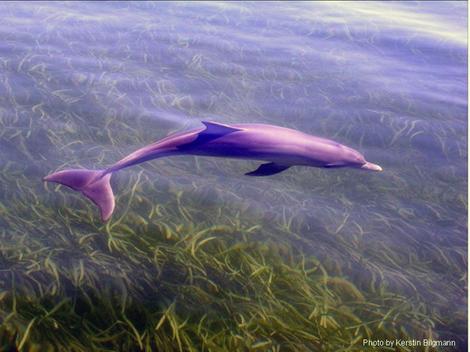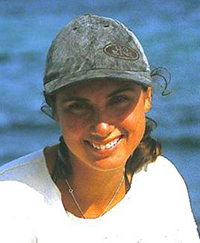New Dolphin Discovered
Posted by: Loren Coleman on November 19th, 2008

Australian scientists have discovered a previously unknown dolphin swimming in their nation’s southern waters.
Until now it had been thought the world had just two species of bottlenose dolphins. The common bottlenose, generally at home in offshore waters, and the more coastal Indo-Pacific species, are both found near Australia.
However, Macquarie and Monash university researchers, collecting genetic samples from what they thought were coastal dolphins, made an unexpected find. After DNA testing about 200 mammals off Victoria, South Australia and Tasmania for a population study, the scientists realised they were not coastal bottlenose dolphins at all.

“They look alike but they are genetically quite different,” Luciana Möller (above), of Macquarie University, said yesterday. “We were surprised.” The biologist received her PhD in Environmental Studies in 2001. She has been working in the field of cetacean behavioural ecology and mate selection for years, specifically, in Australia, 1997-2005; in the United States, 1995; in Brazil, 1990-1995; and Antarctic, 1994.
Such finds, said Dr. Möller, were “pretty rare”.
“Large mammals are not discovered very often. It shows we still have a lot to learn about how many marine species are out there. In the current biodiversity crises, when we are losing so many animal species, it is very exciting to find out about these unique Australian dolphins,” she said.
Möller suspected that the new species, and the previously known coastal bottlenose dolphins, probably separated “quite recently … in the past few million years”.
The DNA tests suggested the new species was probably more closely related to the Fraser’s dolphin, from the deep waters of the Pacific.
Möller said she believed the limited range of the new species meant it deserved special protection.
“Due to their coastal habitat, these dolphins are also more likely to face threats such as pollution, overfishing and entanglement in nets,” Möller noted.
Details of the discovery have been published in Molecular Phylogenetics And Evolution.
Reference:
Möller LM, Bilgmann K, Charlton-Robb K, Beheregaray LB (2008) Multi-gene evidence for a new species of bottlenose dolphin in southern Australia. Molecular Phylogenetics and Evolution. In press.
About Loren Coleman
Loren Coleman is one of the world’s leading cryptozoologists, some say “the” leading living cryptozoologist. Certainly, he is acknowledged as the current living American researcher and writer who has most popularized cryptozoology in the late 20th and early 21st centuries.
Starting his fieldwork and investigations in 1960, after traveling and trekking extensively in pursuit of cryptozoological mysteries, Coleman began writing to share his experiences in 1969. An honorary member of Ivan T. Sanderson’s Society for the Investigation of the Unexplained in the 1970s, Coleman has been bestowed with similar honorary memberships of the North Idaho College Cryptozoology Club in 1983, and in subsequent years, that of the British Columbia Scientific Cryptozoology Club, CryptoSafari International, and other international organizations. He was also a Life Member and Benefactor of the International Society of Cryptozoology (now-defunct).
Loren Coleman’s daily blog, as a member of the Cryptomundo Team, served as an ongoing avenue of communication for the ever-growing body of cryptozoo news from 2005 through 2013. He returned as an infrequent contributor beginning Halloween week of 2015.
Coleman is the founder in 2003, and current director of the International Cryptozoology Museum in Portland, Maine.










This is an exciting discovery, but it isn’t exactly finding a new large mammal since the dolphins were already well known to exist in the area. Their actual existence was not in dispute, they just hadn’t been recognized for what they really were and were thought to be the coastal dolphins. The new discovery here was at the genetic level, which I think is a quite a bit different (less spectacular for some perhaps) than if they had found a completely new large marine animal that had been eluding discovery.
Still, it is always amazing to me how in this day and age we have come to the point where we can discern the genetic differences between similar species in order to get a more accurate idea of the biodiversity of life on Earth. It seems the already sometimes fuzzy line between species is getting ever more complicated and tricky, which I feel will only help our understanding of biology. New techniques and technologies are further amending our ideas of what exactly constitutes a species and this is an exciting area for me. Of course, I am a splitter when it comes to taxonomy, so some may beg to differ.
By the way, that picture at the top is gorgeous!
Pink dolphin: http://www.twistedproduction.com/images/pink-dolphin.jpg
Orange dolphin: http://www.afsc.noaa.gov/nmml/education/images/franciscana01.jpg
Red dolphin: http://www.swimwithdolphins.co.uk/images/dolphinreef.jpg
Brown dolphin: http://isurus.mote.org/~bgriffin/program_files/image014.jpg
Black dolphin: http://www.123dolphin.com/dolphin-images/40_black_dolphin.jpg
White dolphin: http://www.wwf.org.hk/images/pressreleases/20061019-3.jpg
Blue dolphin: http://www.hitech-dolphin.com/image-files/dolphin-ocean-picture.jpg
Grey dolphin: http://z.about.com/d/cameras/1/0/z/2/Dolphin.jpg
Striped dolphin: http://www.crru.org.uk/images/striped4.jpg
Funky black and white dolphin: http://weblog.greenpeace.org/oceandefenders/images/stop_whaling2007/GJN_3142-01_dolphin.jpg
Speckled pink and grey: http://www.oceanleadership.org/sea90e/images/education/about/speckled.gif
Speckled blue and pink: http://csiwhalesalive.org/csi00013Sc.jpg
and your requested Colossal dolphin – orange belly, black on back, faded bluish pink: http://i.pbase.com/u47/baywing/upload/30106278.AtlanticWhiteSidedDolphin.jpg
Chris.
Those are great points from Mystery Man. While I wouldn’t consider my self either a “clumper” or a “splitter” when it comes to communities of species, I sure do find the emerging concepts of cladistics fascinating particularly in the cohesively structured way it presents our relatedness to other species and it looks like it’s there that scientific research will find any number of previously unknown and distinct but urecognized populations. In the case of these coastal cetaceans, let’s hope we do it before their habitat “disappears”, or more accurately gets destroyed by human impacts, something the previously-thought, seemingly-limitless coastal areas are experiencing at an accelerating rate, the likes of which have never been seen before. Think about that next time one throws another farm-raised or wild-caught shrimp on the old barbie.
Love how it more closely resembles Fraser’s. That’s a dolphin type I’ve always had a particular interest in.
Generic or not, it’s still exciting to find more kinds of anything in this world. Particulalry dolphins.
We need more laughter from them in this world of ours.
At the risk of sounding pathologically cynical, am I the only one who thinks the photo looks “funny”? I have no reason to doubt that the discovery is real, but I wonder if this “photo” is merely an illustration of the animal or is a real photograph that has been retouched for clarity.
Great pics, Chris. Thanks!
I think the photo’s genuine. The dolphin is distorted because of the angle of the photo against the water.
I wonder if the tail flukes are proportionally thinner, with a wider span, than for other bottlenose?
Yup the picture does sorta look photoshoped for Better Quality drawing, but i think it’s the real deal. 🙂
Thanks Chris for the pictures. XD didn’t know they were real. 🙂
the last pic you posted didn’t work (collossal dolphin) didn’t work. 🙂